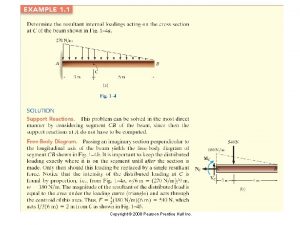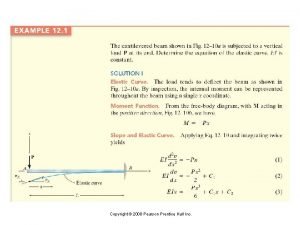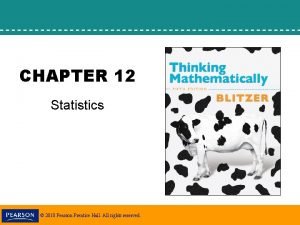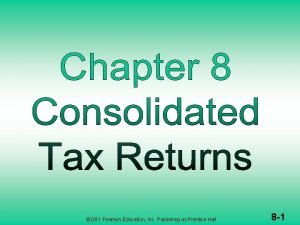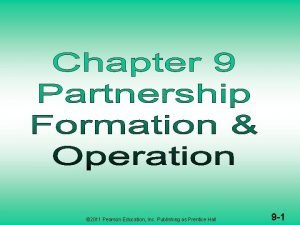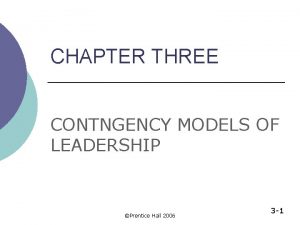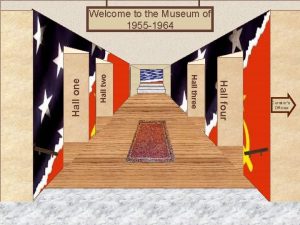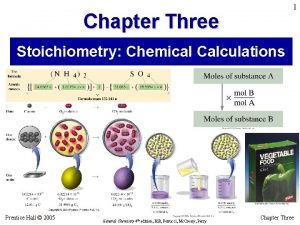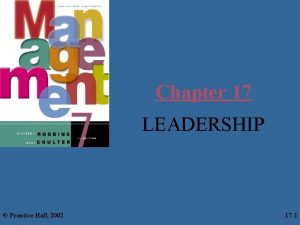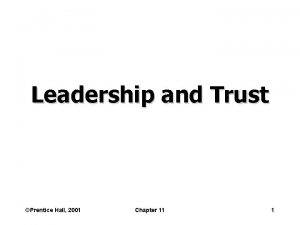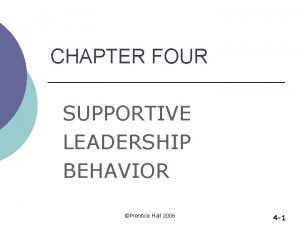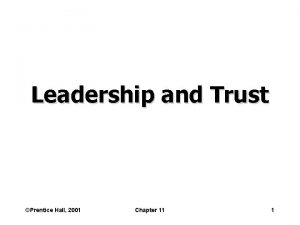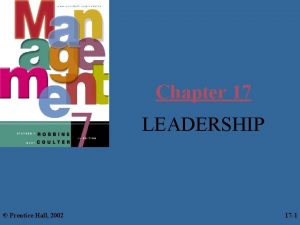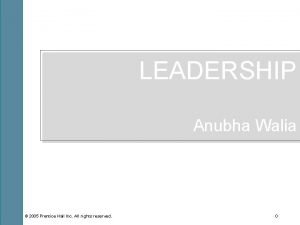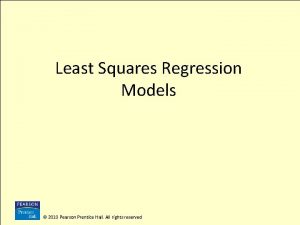CHAPTER THREE CONTNGENCY MODELS OF LEADERSHIP Prentice Hall
























- Slides: 24

CHAPTER THREE CONTNGENCY MODELS OF LEADERSHIP ©Prentice Hall 2006 3 -1

Learning Objectives After reading this chapter, you should be able to do the following: ¡ ¡ ¡ Describe the concept of contingency theories of leadership. Explain the two leadership styles used in Fiedler’s Contingency Model of leadership. Use Fiedler’s Contingency Model to predict the leadership style that will be most effective. Describe the four leadership styles of the Hersey and Blanchard Situational Leadership Model. Explain the relationship described by the Situational Leadership Model between leadership styles and followers’ competence and commitment. ©Prentice Hall 2006 3 -2

Learning Objectives (cont. ) After reading this chapter, you should be able to do the following: ¡ ¡ Describe the four leader behaviors of Path-Goal Theory of leadership and their motivational effects. Discuss the recommendations of Path-Goal Theory for effective leader behaviors. Describe the Multiple Linkage Model of leadership and its recommendations for leader behavior to improve group performance. Describe the Normative Decision Making Model of participative leadership. ©Prentice Hall 2006 3 -3

Leadership Models ¡ One-Best Style Approach l l ¡ Assume that one style is effective in all situations Common elements include participation, delegation, group involvement, and vision Situational Models l l Leader's impact on followers is contingent Leader's Characteristics and Behavior Organizational Characteristics Follower Characteristics ©Prentice Hall 2006 3 -4

Fiedler’s Contingency Model of Leadership A situational theory that focuses on the match between the leader’s predisposition or style and the characteristics of the situation. ©Prentice Hall 2006 3 -5

Leadership Self-Assessment: Leadership Style as Indicated by Least Preferred Co -Worker (LPC) Scale Instructions: Think of the person with whom you can work least well. It does not have to be the person you like least well, but should be the person with whom you had the most difficulty in getting a job done. Describe this person by circling a number for each scale. Pleasant Friendly Rejecting Helpful Unenthusiastic Tense Distant Cold Cooperative Supportive Boring Quarrelsome Self-Assured Efficient Gloomy Open 8 8 1 1 1 1 8 8 1 8 7 7 2 2 2 2 7 7 2 7 6 6 3 3 3 3 6 6 3 6 5 5 4 4 4 4 5 5 4 5 4 5 5 4 4 5 4 ©Prentice Hall 2006 3 3 6 6 6 6 3 3 6 3 2 2 7 7 7 7 2 2 7 2 1 1 8 8 8 8 1 1 8 1 Unpleasant Unfriendly Accepting Frustrating Enthusiastic Relaxed Close Warm Uncooperative Hostile Interesting Harmonious Hesitant Inefficient Cheerful Guarded 3 -6

Interpreting Your LPC Score Your LPC score is the sum of the answers to the 16 items. According to Fiedler’s Contingency Theory, a score greater than 76 indicates a relationship orientation, and a score of less than 62 indicates a task orientation. A score of 58 to 63 places you in the intermediate range, which indicates socioindependent leadership orientation. ©Prentice Hall 2006 3 -7

Fiedler’s Contingency Model of Leadership Situation Classification and Leader Type Octant I Leader-Member Relations Task Structure Position Power Recommended Leader Type II IV V Structured Unstructured Low High Task-Motivated (Low LPC) Socioindependent (Medium LPC) VIII Poor Good High VI Low Structured High Low Unstructured High Relationship-Motivated (High LPC) ©Prentice Hall 2006 Low Task. Motivated (Low LPC) 1 -8

Hersey & Blanchard’s Behavioral Recommendations for Leaders Subordinate Developmental Level Supportiveness Directiveness Low Competence & High Commitment Low High Directing Some Competence & Low Commitment High Coaching High Competence & Variable Commitment High Low Supporting High Competence & High Commitment Low Empowering Leader Behavior ©Prentice Hall 2006 Leadership Style 1 -9

Path-Goal Theory of Leadership A contingency theory that addresses a leader’s interaction with individual followers. ©Prentice Hall 2006 3 -10

Four Types of Leader Behavior Usually Included in the Path-Goal Theory Model ¡ Directive ¡ Supportive ¡ Participative ¡ Achievement-oriented ©Prentice Hall 2006 3 -11

Predicted Effects of Path-Goal Leader Behaviors Leader Behavior Predicted Motivational Effects Directive • Reduces role ambiguity; increases follower beliefs that effort will result in good performance and performance will be rewarded. Supportive • Increases self-confidence; increases the personal value of job-related effort. Participative Achievement. Oriented • Reduces ambiguity, clarifies expectations, increases consistency of subordinate and organizational goals, increases involvement with and commitment to organizational goals. • Increases subordinate confidence and the personal value of goal-directed effort. ©Prentice Hall 2006 3 -12

Revised Path-Goal Theory Leader Behaviors General Leader Behaviors Clarifying Specific Leader Behaviors • Clarifying performance goals, standards, and means to achieve them • Clarifying whom subordinates should respond to Implementing contingency rewards and punishments Participative • Consulting with subordinates • Incorporating subordinate opinions in decision making Achievement. Oriented • Setting high goals and seeking improvement • Emphasizing excellence and showing confidence in subordinates • Stressing pride in work. Work Facilitation • Planning, scheduling, and organizing work • Coordinating subordinates’ work • Guiding, coaching, counseling, and giving feedback • Eliminating roadblocks and bottlenecks • Providing resources • Delegating authority to subordinates ©Prentice Hall 2006 3 -13

Revised Path-Goal Theory Leader Behaviors (cont. ) General Leader Behaviors Specific Leader Behaviors Supportive • Creating a friendly and psychologically supportive environment • Displaying concern for subordinates’ welfare Interaction Facilitation • Resolving disputes and facilitating communication • Giving minority views a hearing • Emphasizing collaboration and teamwork • Encouraging close relationships among team members Group-Oriented Decision Processes • Posing problems to the group • Searching for mutual interests in problem solving • Encouraging participation by all group members • Searching for and displaying alternatives • Delaying evaluation until alternatives are found • Encouraging evaluation of all alternatives • Combining advantages of alternatives to create solutions Shared Leadership • Encouraging subordinates to behave as leaders • Setting an example for subordinates to follow ©Prentice Hall 2006 3 -14

Revised Path-Goal Theory Leader Behaviors (cont. ) General Leader Behaviors Representing and Networking Charismatic Specific Leader Behaviors • Representing the group in a favorable way • Communicating the importance of the group’s work • Maintaining positive relations with influential others • Being an effective trading partner • Keeping in touch with network members • Participating in social functions and ceremonies • Doing favors for others • Showing positive regard for others • Articulating a vision of a better future • Displaying a passion for the vision • Displaying self-sacrifice in the interest of the vision • Demonstrating self-confidence, confidence in the attainment of the vision, and determination and persistence in the interest of the vision • Selectively arousing non-conscious motives of followers • Taking extraordinary personal and organizational risks • Communicating high performance expectations • Using symbolic behaviors to emphasize values • Providing frequent positive evaluation of followers ©Prentice Hall 2006 3 -15

Leadership Behaviors in Yukl’s Multiple Linkage Model Broad Behavior Building Relationships Influencing People Mid-Range Behaviors Supporting Specific Behaviors Being friendly, showing concern, listening to problems, giving advice and support Networking Developing and maintaining positive relationships with influential others Managing Conflict and Team Building Reducing and resolving disputes, facilitating communication, encouraging teamwork and cooperation Motivating Rewarding and Recognizing Influencing subordinates to achieve work goals, setting good behavioral examples Providing valued rewards, praise, and recognition for performance; expressing appreciation, respect, and admiration for achievement ©Prentice Hall 2006 3 -16

Leadership Behaviors in Yukl’s Multiple Linkage Model (cont. ) Broad Behavior Making Decisions Giving. Seeking Information Mid-Range Behaviors Specific Behaviors Problem Solving Identifying and analyzing problems and solutions; implementing and evaluating solutions Planning and Organizing Determining objectives, strategies, and actions needed to improve efficiency and productivity Consulting and Delegating Discussing decision options with subordinates, asking for input from subordinates, and allowing subordinates some autonomy in decision making Monitoring Collecting information on work progress and quality, determining opportunities, threats, and needs Clarifying Providing direction; telling subordinates what, how, and when to do certain tasks Informing Providing information subordinates need to do their work and to understand the importance of their work ©Prentice Hall 2006 3 -17

Normative Decision Making Model of Participation The Model involves the degree of participation that followers should be allowed in different decision making situations. Leader Decision-making styles l l l Decide alone Consult Individually Consult Group Facilitate. Delegate ©Prentice Hall 2006 3 -18

The Time-Driven Model Instructions: The matrix operates like a funnel. You start at the left with a specific decision problem in mind. The column headings denote situational factors which may or may not be present in that problem. You progress by selecting High or Low (H or L) for each relevant situational factor. Proceed down from the funnel, judging only those situational factors for which a judgment is called for, until you reach the recommended process. Source: Vroom, V. H. (2000). Leadership and the decision making process. Organizational Dynamics, 28(4), 82 -94. ©Prentice Hall 2006 3 -19

Summary of Leader Situational Factors, and Leader Effects Follower’s Psychological Situational Characteristics Reactions Follower & Group Outcomes High group performance Contingency Theories Leader Behaviors or Predispositions Fiedler’s Contingency Model Task-Oriented Relationship. Oriented Leader-member relations Task structure Leader’s position power Hersey & Blanchard’s Situational Leadership Model Task-Oriented/ Directive Relationship. Oriented/Supportive Follower development Task relevant maturity ©Prentice Hall 2006 Satisfaction Commitment High follower performance 3 -20

Summary of Leader Situational Factors, and Leader Effects (cont. ) Contingency Theories Leader Behaviors or Predispositions Situational Characteristics House’s Path-Goal theory Directive Supportive Participative Achievement. Oriented Work Facilitation (e) Interaction Facilitation (e) Group-Oriented (e) Representative (e) Charismatic (e) Shared Leadership (e) Task structure or ambiguity Frustrating, stressful, or dissatisfying task Challenging tasks Low follower authoritarianism or high need for independence Follower’s Follower & Psychological Group Reactions Outcomes Satisfaction Motivation Acceptance of the leader Job clarity High effort High follower performance Low levels of grievances & turnover High group performance(e) - indicates items which are part of a recently expanded version of this model with no research support. 3 -21 ©Prentice Hall 2006

Summary of Leader Situational Factors, and Leader Effects (cont. ) Contingency Theories Yukl’s Multiple Linkage Model Leader Behaviors or Predispositions Supporting Networking Managing conflict Team building Motivating Rewarding & recognizing Problem solving Planning & organizing Consulting & delegating Monitoring Clarifying Informing Situational Characteristics Organization’s reward system Follower’s tasks Policies and procedures Technology of the workplace Organizational crises or major change Follower’s characteristics Economic conditions ©Prentice Hall 2006 Follower’s Psychological Reactions Follower & Group Outcomes Job knowledge High effort Organization of the work Adequate resources Cooperation and group cohesion Role clarity Coordination with other groups High group performance 3 -22

Summary of Leader Situational Factors, and Leader Effects (cont. ) Contingency Theories Leader Behaviors or Predispositions Vroom. Yetton-Jago’s Normative Model of Decision Making Five Decision-making Styles • Decide • Consult individually • Consult Group • Facilitate • Delegate Situational Characteristics Decision significance Importance of commitment Leader’s expertise Likelihood of commitment Group support for objectives Group expertise Team competence ©Prentice Hall 2006 Follower’s Psychological Reactions Follower & Group Outcomes High decision acceptance High decision quality Decision timeliness Cost of decisionmaking Opportunities for learning and development 3 -23

Summary of Leader Situational Factors, and Leader Effects (cont. ) Contingency Theories Leader Behaviors or Predispositions Vroom. Yetton-Jago’s Normative Model of Decision Making Five Decision-making Styles • Decide • Consult individually • Consult Group • Facilitate • Delegate Situational Characteristics Decision significance Importance of commitment Leader’s expertise Likelihood of commitment Group support for objectives Group expertise Team competence ©Prentice Hall 2006 Follower’s Psychological Reactions Follower & Group Outcomes High decision acceptance High decision quality Decision timeliness Cost of decisionmaking Opportunities for learning and development 3 -24
 Pearson education inc publishing as pearson prentice hall
Pearson education inc publishing as pearson prentice hall Pearson prentice hall
Pearson prentice hall 2008 pearson prentice hall inc
2008 pearson prentice hall inc Copyright 2005 pearson prentice hall inc
Copyright 2005 pearson prentice hall inc Pearson prentice hall
Pearson prentice hall Prentice hall inc
Prentice hall inc Prentice hall careers
Prentice hall careers Prentice hall america pathways to the present
Prentice hall america pathways to the present Pearson education inc. publishing as prentice hall
Pearson education inc. publishing as prentice hall Prentice hall business publishing
Prentice hall business publishing Prentice hall african american history
Prentice hall african american history Pearson physical science concepts in action answers
Pearson physical science concepts in action answers 2011 pearson education inc
2011 pearson education inc Pearson prentice hall
Pearson prentice hall Pearson prentice hall
Pearson prentice hall 2005 pearson prentice hall inc
2005 pearson prentice hall inc Pearson education inc publishing as pearson prentice hall
Pearson education inc publishing as pearson prentice hall Phylum arthropoda common name
Phylum arthropoda common name Prentice hall business publishing
Prentice hall business publishing Pearson education inc. publishing as prentice hall
Pearson education inc. publishing as prentice hall Pearson education 2012
Pearson education 2012 Pearson education inc. 2012
Pearson education inc. 2012 Prentice hall jobs
Prentice hall jobs 2011 pearson education inc
2011 pearson education inc 2011 pearson education inc
2011 pearson education inc

